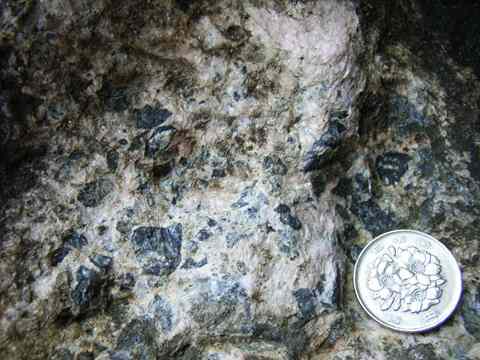Ryushima Mine
Azumi, Matsumoto city, Nagano pref., Japan
Occurrence
Moderate-T hydrothermal deposit
Mn-dominant moderate temperature hydrothermal deposit formed by Nagawa Granite intruded in Misogawa Complex of Mino Belt. Approximately 2.5 km apart from Nagawa Granite, the heat source.

Outcrop of a kutnahorite vein network in slate of Misogawa Complex. The pale pink network is veins of massive kutnahorite, and euhedral crystals are in open spaces of the vein. Black host is silicified slate. Brownish-black crusts on the outcrop surface at the upper left and the upper right are pyrolusite formed by weathering of kutnahorite.
Reported Minerals
- Kutnohorite
- Pyrolusite
- Pyrite
- Sphalerite
- Galena
Mineral Assemblages
- Kutnohorite - Pyrolusite
- Kutnohorite - Sphalerite - Galena - Pyrite
History
- 1899: Mr. Fukazawa, a local person, found the deposit.
- 1921: Mr. Amano from Osaka started to mine manganese ore.
- 1927: Restarted to mine 10-50 t/month ore.
Localities
- Kisan-mori Mine (Cu-Pb-Zn)
- Mikawa Mine (Cu-Pb-Zn, Siderite)
- Takami Mine (Cu-Pb-Zn)
- Gunma Mine (Cu-Pb-Zn)
- Yunosawa Mine (Pb-Zn)
- Okuto Mine (Pb-Zn)
- Arakawa Mine (Cu-Zn)
- Osarizawa Mine (Cu-Zn)
- Sayama Mine (Cu-Zn)
- Washinosu Mine (Cu-Zn)
- Yashu Mine (Cu)
- Takaneyama Mine (Cu-Zn-Mn)
- Kawazu Mine (Zn-Au-Te-Mn)
- Manju Mine (Zn)
- Mount Nesugata (Mn oxide)
- Ryushima Mine (Mn carbonate)